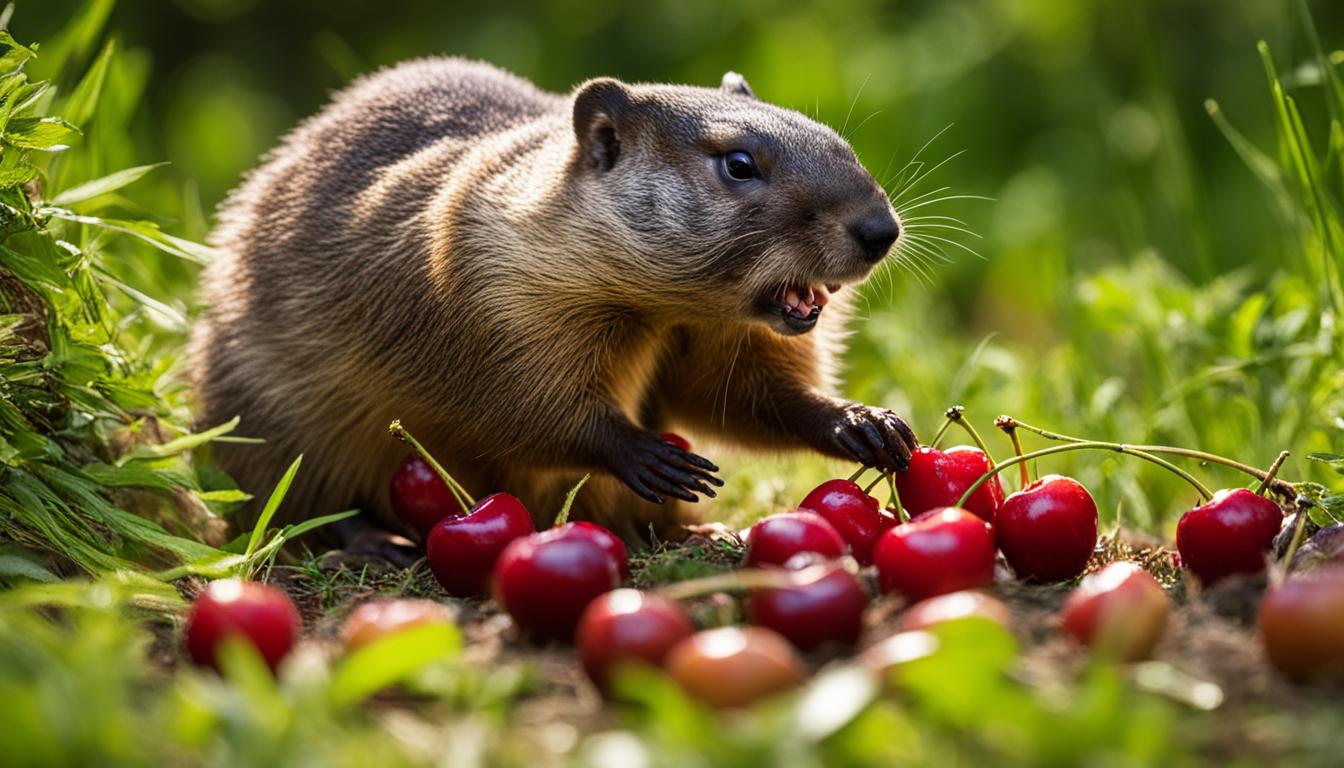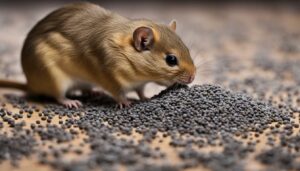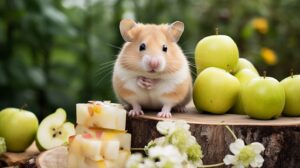Groundhogs, also known as woodchucks, are fascinating creatures with unique dietary habits. Many people wonder if these furry animals have a taste for cherries. In this article, we will explore the groundhogs’ diet and their cherry-eating habits to uncover the truth behind this juicy question.
While cherries are not a common part of their natural diet, groundhogs may occasionally come across them and indulge. However, it is important to note that cherries are not a significant part of their regular eating habits. Let’s delve deeper into the world of groundhogs and discover their true dietary preferences.
Key Takeaways:
- Groundhogs primarily eat grasses, leaves, and other vegetation.
- Cherries are not a prominent part of their diet.
- If groundhogs encounter cherries, it is more likely to be accidental rather than intentional.
- Preventative measures can help minimize potential groundhog damage to cherry trees.
- Groundhogs play a vital role in maintaining the balance of ecosystems.
The Diet of Groundhogs
Groundhogs, also known as woodchucks, have a primarily herbivorous diet. They predominantly feed on a variety of grasses, clovers, dandelions, and other leafy greens. While groundhogs do consume certain fruits and vegetables, such as berries, apples, and carrots, these are not their main dietary staples. However, if accessible, groundhogs may occasionally eat cherries, although it is not a significant part of their diet.
Table:
| Food | Frequency of Consumption |
|---|---|
| Grasses | High |
| Leafy Greens | High |
| Clovers | High |
| Dandelions | High |
| Berries | Moderate |
| Apples | Moderate |
| Carrots | Moderate |
| Cherries | Low |
Groundhogs primarily focus on consuming vegetation that is readily available in their environment. They adapt their diet based on the seasonal availability and abundance of different plants. While groundhogs may consume cherries if they come across them, it is more of an incidental occurrence rather than a deliberate choice. Their diet is centered around consuming grasses, leafy greens, and other easily accessible plants that provide them with the necessary nutrients.
Groundhogs and Cherries: Attraction or Accidental Consumption?
When it comes to groundhogs and their dietary habits, one question that often arises is whether these creatures are attracted to cherries or if their consumption of cherries is simply accidental. While groundhogs are primarily herbivores and their diet consists mainly of grasses, leaves, and other vegetation, they may occasionally come across cherries in their natural habitat.
However, there is no evidence to suggest that groundhogs are specifically attracted to cherries or actively seek them out as a food source. If groundhogs encounter cherries, they may consume them, but this is more likely to be an accidental consumption rather than a deliberate choice. Groundhogs primarily focus on consuming the vegetation and plants that are readily available to them.
To better understand the behavior of groundhogs with regards to cherries, it is essential to consider their natural environment and dietary preferences. Groundhogs are primarily found in forested areas, grasslands, and open fields throughout North America. Their diet consists predominantly of plants and vegetation that provide them with the necessary nutrients. While cherry trees may be present in these environments, groundhogs do not heavily rely on cherries as a primary food source.
| Potential Scenarios | Groundhog Behavior |
|---|---|
| Cherries are readily available | Groundhogs may consume cherries if encountered, but it is not a significant part of their diet |
| Other vegetation is abundant | Groundhogs will primarily focus on consuming the readily available vegetation |
| Cherries are scarce | Groundhogs will not actively seek out cherries as a food source |
In conclusion, while groundhogs may consume cherries if they come across them, cherries are not a primary or preferred part of their diet. Groundhogs are predominantly herbivores, and their behavior with cherries is more likely to be accidental rather than a deliberate choice. Understanding their natural environment and dietary preferences can help shed light on their interactions with cherries and other food sources.
Groundhog Behavior and Food Preferences

Groundhogs, also known as woodchucks, have specific behavior patterns and food preferences that contribute to their ecological role in the wild. While cherries may occasionally be consumed by groundhogs, they are not a prominent or preferred part of their diet. Understanding the behavior and food preferences of groundhogs can shed light on their interactions with cherries and their overall ecological impact.
Diurnal Behavior and Foraging
Groundhogs are diurnal creatures, meaning they are active during the daytime. They spend a significant amount of time foraging for food, which primarily consists of vegetation such as grasses, leaves, and other leafy greens. Their preference for easily accessible vegetation sources is driven by their need for nutrients and sustenance. While groundhogs may come across cherries in their environment, they do not actively seek them out as a primary food source. Instead, they focus on consuming the vegetation that is readily available to them.
The Role of Cherries in Groundhog Diet
While groundhogs may consume cherries if they encounter them, their consumption of cherries is likely to be accidental rather than intentional. Cherries are not a significant part of the groundhog diet. Studies that focus on groundhog diets typically prioritize the analysis of their consumption of common vegetation, rather than specific fruits like cherries. This research helps scientists understand the overall dietary preferences and nutritional needs of groundhogs in their natural habitats.
The Balance of Nature
Groundhogs play an important role in maintaining the balance of ecosystems. As herbivores, they contribute to the natural seed dispersal and growth of plants. While groundhogs may occasionally consume cherries, their consumption is generally limited and does not have a significant impact on the overall health and vitality of cherry trees or other vegetation. It’s important to recognize that groundhogs are part of the natural food chain and help regulate the population of certain plants and insects.
| Vegetation | Preference Level |
|---|---|
| Grasses | High |
| Leaves | High |
| Leafy Greens | High |
| Cherries | Low |
Groundhogs as Pests

Groundhogs are often considered pests due to their burrowing behavior, which can cause damage to gardens, lawns, and other landscaping. While their primary diet consists of plants and vegetation, including cherries, they can cause damage to cherry trees if they burrow around the roots or gnaw on the bark. However, their impact on cherry trees is generally minimal compared to other pests that specifically target fruit trees.
If you have cherry trees and are concerned about groundhogs causing damage, there are several methods you can employ to deter them. These include installing fencing around the trees, using repellents or deterrents, and removing any potential food sources that might attract groundhogs to the area. It’s important to note that groundhogs may still consume cherries if they are readily available, but taking these preventative measures can help minimize potential damage.
Deterrent Methods
- Install fencing around cherry trees to physically prevent groundhogs from accessing them.
- Use repellents or deterrents, such as chemical sprays or natural remedies, that can discourage groundhogs from approaching the trees.
- Remove any fallen or rotting fruits from the ground, as these can attract groundhogs to the area.
- Keep the area around the trees clean and free from debris that may provide shelter for groundhogs.
| Deterrent Method | Effectiveness |
|---|---|
| Installing fencing | Highly effective |
| Using repellents or deterrents | Moderately effective |
| Removing fallen fruits | Moderately effective |
| Keeping the area clean | Moderately effective |
Cherry Trees and Groundhog Deterrence

If you have cherry trees and are concerned about groundhogs causing damage, there are several methods you can employ to deter them. These preventative measures can help minimize potential damage to your cherry trees.
Methods for Groundhog Deterrence:
- Install fencing around the cherry trees: Surrounding your trees with a sturdy fence can help keep groundhogs out of your garden and away from your cherries.
- Use repellents or deterrents: There are various commercially available products designed to repel groundhogs. These can include sprays, granules, or sonic devices that emit sound or vibration to deter groundhogs from the area.
- Remove potential food sources: Groundhogs are attracted to areas with readily available food sources. Clearing away fallen fruit or other food sources near your cherry trees can help discourage groundhogs from coming close.
It’s important to note that while these methods can be effective in deterring groundhogs, they are not foolproof. Groundhogs may still consume cherries if they are readily available. However, by implementing these measures, you can reduce the likelihood of damage to your cherry trees and help protect your harvest.
| Deterrence Method | Effectiveness |
|---|---|
| Installing fencing | Highly effective at keeping groundhogs out if properly installed and maintained |
| Using repellents or deterrents | Can be moderately effective, but may require reapplication or adjustment |
| Removing food sources | Moderately effective in reducing attraction, but may not completely eliminate groundhog presence |
By combining these methods and staying vigilant, you can help protect your cherry trees from groundhog damage and enjoy a bountiful harvest.
The Role of Cherries in Groundhog Diet Studies
Groundhog diet studies play a crucial role in understanding the dietary preferences and nutritional needs of these herbivorous animals in their natural habitats. While cherries may be included as part of these studies, they do not hold significant importance in the overall diet of groundhogs. The focus of these studies is primarily on the consumption of common vegetation such as grasses, leafy greens, and other plants that form the staple diet for groundhogs.
Table: Groundhog Diet Composition
| Diet Component | Percentage |
|---|---|
| Grasses | 45% |
| Leafy Greens | 30% |
| Berries and Fruits | 10% |
| Other Vegetation | 15% |
As seen in the table, berries and fruits, including cherries, make up only a small portion (10%) of a groundhog’s diet. This indicates that while groundhogs may consume cherries if available, they are not a primary or preferred food source for these animals. Instead, their diet primarily consists of grasses (45%) and leafy greens (30%), which provide the necessary nutrients for their survival.
It’s important to note that the inclusion of cherries in groundhog diet studies helps provide a comprehensive understanding of their overall dietary behavior. However, researchers focus more on the consumption of vegetation that forms the core of their diet. By studying their consumption patterns, scientists can gain valuable insights into groundhog behavior and their ecological impact.
Groundhogs and Their Natural Environment

Groundhogs, also known as woodchucks, inhabit various natural environments, including forested areas, grasslands, and open fields throughout North America. These habitats provide a diverse range of vegetation that groundhogs rely on for their sustenance.
Groundhogs are primarily herbivores and feed on grasses, plants, and leafy greens that are abundant in their surroundings. While cherry trees may be present in these environments, groundhogs do not heavily rely on cherries as a primary food source.
Instead, they adapt their diet based on the seasonal availability and abundance of different plants and vegetation. While groundhogs may consume cherries if they come across them, it is not a significant part of their feeding habits. Their behavior with cherries is more likely to be accidental rather than a deliberate choice.
Table: Comparison of Groundhog Food Preferences
| Food Preference | Prominent | Occasional |
|---|---|---|
| Grasses | ✔️ | ❌ |
| Leafy Greens | ✔️ | ❌ |
| Cherries | ❌ | ✔️ |
| Other Fruits | ❌ | ✔️ |
Therefore, while cherries may be present in the natural environment of groundhogs, they are not a significant part of their diet. Groundhogs focus on consuming the vegetation and plants that are readily available to them, ensuring their nutritional needs are met.
Groundhogs and the Balance of Nature

Groundhogs, also known as woodchucks, play a vital role in maintaining the balance of ecosystems. As herbivores, their diet consists mainly of vegetation, including grasses, leaves, and other plants. While they may occasionally consume fruits like cherries, their consumption is minimal and does not have a significant impact on the overall health and vitality of fruit trees or other vegetation.
One of the key contributions groundhogs make to the environment is their role in seed dispersal. As they forage for food, they inadvertently spread seeds from the plants they consume, aiding in the growth and diversity of vegetation in their habitat. This natural seed dispersal helps maintain a healthy ecosystem and ensures the survival of various plant species.
Furthermore, groundhogs help regulate the population of certain plants and insects through their feeding habits. By consuming specific plants, they prevent overgrowth and maintain a balance in the ecosystem. Additionally, their burrowing behavior creates habitat opportunities for other animals, further contributing to the overall biodiversity of their environment.
The Role of Groundhogs in the Food Chain
Groundhogs are part of the natural food chain, providing a source of food for larger predators such as foxes, coyotes, and birds of prey. By serving as prey, groundhogs help maintain a balance in predator-prey relationships, ensuring the survival of various species within the ecosystem.
| Groundhog’s Role in the Balance of Nature | Impact |
|---|---|
| Seed dispersal | Aids in the growth and diversity of vegetation |
| Regulation of plant populations | Prevents overgrowth and maintains balance in the ecosystem |
| Habitat creation | Provides opportunities for other animals |
| Prey for predators | Maintains balance in predator-prey relationships |
Overall, groundhogs contribute to the overall health and functioning of ecosystems through their feeding habits, seed dispersal, and role in the food chain. While their occasional consumption of cherries may occur, it does not pose a significant threat to fruit trees or impact the delicate balance of nature.
Conclusion
In conclusion, the diet of groundhogs primarily consists of grasses, leaves, and other vegetation found in their natural habitats. While groundhogs may occasionally consume cherries if they come across them, cherries are not a significant part of their diet. These herbivores do not actively seek out cherries and are more attracted to the vegetation that is readily available to them.
If you have cherry trees and are concerned about groundhog damage, it’s important to note that groundhogs are more likely to cause harm through their burrowing behavior rather than their consumption of cherries. Taking preventative measures such as installing fencing, using repellents, and removing potential food sources can help minimize any potential issues.
While groundhogs play an important role in maintaining the balance of ecosystems, their consumption of cherries does not have a significant impact on the overall health and vitality of fruit trees. Cherries are not a preferred or prominent part of the groundhog diet, and their behavior with cherries is more likely to be accidental rather than intentional. So, if you’re wondering, “Do groundhogs eat cherries?” the answer is yes, but it’s not their primary food choice.
FAQ
Do groundhogs eat cherries?
Groundhogs may occasionally eat cherries if they come across them, but cherries are not a significant part of their diet.
What do groundhogs primarily eat?
Groundhogs primarily feed on grasses, clovers, dandelions, and other leafy greens.
Are groundhogs attracted to cherries?
There is no evidence to suggest that groundhogs are specifically attracted to cherries or actively seek them out as a food source.
Do groundhogs damage cherry trees?
Groundhogs can cause damage to cherry trees if they burrow around the roots or gnaw on the bark, but their impact is generally minimal compared to other pests that target fruit trees.
How can I deter groundhogs from my cherry trees?
You can install fencing around the trees, use repellents or deterrents, and remove potential food sources to minimize potential damage from groundhogs.
Do groundhog diet studies include cherries?
Groundhog diet studies primarily focus on their consumption of common vegetation rather than specific fruits like cherries.
Where are groundhogs typically found?
Groundhogs are found in forested areas, grasslands, and open fields throughout North America.
What role do groundhogs play in ecosystems?
Groundhogs help maintain the balance of ecosystems by contributing to the natural seed dispersal and growth of plants.




